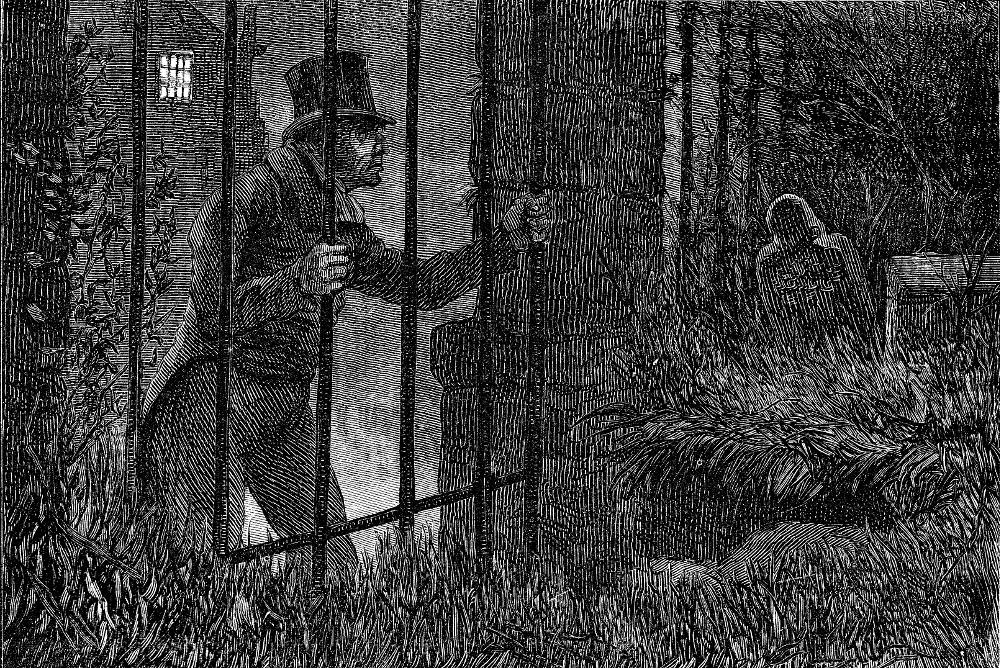
And clasping the iron railings with his hands, looked eagerly in [Page 328] by Charles Stanley Reinhart (1875), in Charles Dickens's The Life and Adventures of Nicholas Nickleby, Harper & Bros. New York Household Edition, for Chapter LXII. 9.1 x 13.6 cm (3 ½ by 5 ⅜ inches), framed. Running head: "The Front Garret" (329). [Click on the images to enlarge them.]
Passage Illustrated: Ralph Nickleby Grows Desperate

C. S. Reinhart's atmospheric depiction of the same scene: Clasping the iron railings with his hands, looked eagerly in, wondering which might be his grave (1857).
Creeping from the house, and slinking off like a thief; groping with his hands, when first he got into the street, as if he were a blind man; and looking often over his shoulder while he hurried away, as though he were followed in imagination or reality by someone anxious to question or detain him; Ralph Nickleby left the city behind him, and took the road to his own home.
The night was dark, and a cold wind blew, driving the clouds, furiously and fast, before it. There was one black, gloomy mass that seemed to follow him: not hurrying in the wild chase with the others, but lingering sullenly behind, and gliding darkly and stealthily on. He often looked back at this, and, more than once, stopped to let it pass over; but, somehow, when he went forward again, it was still behind him, coming mournfully and slowly up, like a shadowy funeral train.
He had to pass a poor, mean burial-ground — a dismal place, raised a few feet above the level of the street, and parted from it by a low parapet-wall and an iron railing; a rank, unwholesome, rotten spot, where the very grass and weeds seemed, in their frouzy growth, to tell that they had sprung from paupers’ bodies, and had struck their roots in the graves of men, sodden, while alive, in steaming courts and drunken hungry dens. And here, in truth, they lay, parted from the living by a little earth and a board or two — lay thick and close — corrupting in body as they had in mind — a dense and squalid crowd. Here they lay, cheek by jowl with life: no deeper down than the feet of the throng that passed there every day, and piled high as their throats. Here they lay, a grisly family, all these dear departed brothers and sisters of the ruddy clergyman who did his task so speedily when they were hidden in the ground! [Chapter LXII, "Ralph Makes One Last Appointment — And Keeps It," 327]
Commentary: Psychological Projections
Having disappeared from the Cheerybles' house after learn that the son he thought he had lost infancy has turned out o the the boy Smike at Dotheboys Hall. Worse, after Brooker has revealed the secret of Smike's origins (which he had kept from Nickleby all this time), the brothers reveal that Smike has just died. Having lost his son all over again, Ralph, in a deep depression, has just stopped on his way home at the gates to the burial ground where a suicide who coroner's inquest he attended as a juryman lies buried. The illustrations by Barbard and Reinhart in the British and American Household Editions both emphasize Ralph's deep depression and prepare readers for his suicide in the front garret of the house in Golden Square. The American illustration, although very much a dark plate like its British counterpart, is more literal and less abstract, although undoubtedly the intention of both artists is psychological revelation. Both Reinhart and Barnard may be recalling two very specific dark plates, Consecrated Ground (July 1852) and The Morning (August 1853), both by Phiz or Hablot K. Browne in the serialisation of Bleak House. The latter illustration realises the suicude of Lady Deadlock, which follows the revelation that Esther Summerson is her daughter.
Three Earlier Series of Dark Plates by Phiz
Related material by other illustrators (1838 through 1910)
- Nineteenth-Century Britain, a Nation of Debtors
- Convicted Debtors in Charles Dickens's Life and Work
- Nicholas Nickleby (homepage)
- Phiz's 38 monthly illustrations for the novel, April 1838-October 1839.
- Cover for monthly parts
- Charles Dickens by Daniel Maclise, engraved by Finden
- "Hush!" said Nicholas, laying his hand upon his shoulder. (Vol. 1, 1861)
- The Rehearsal (Vol. 2, 1861)
- "My son, sir, little Wackford. What do you think of him, sir?" (Vol. 3, 1861)
- Newman had caught up by the nozzle an old pair of bellows . . . (Vol. 4, 1861).
- Sol Eytinge, Jr.'s 18 Illustrations for the Diamond Edition (1867)
- Fred Barnard's 59 Illustrations for the British Household Edition (1875)
- Harry Furniss's 29 illustrations for Nicholas Nickleby in the Charles Dickens Library Edition (1910)
- Kyd's four Player's Cigarette Cards (1910).
Scanned image, colour correction, sizing, caption, and commentary by Philip V. Allingham. [You may use this image without prior permission for any scholarly or educational purpose, as long as you (1) credit the person who scanned the image, and (2) link your document to this URL in a web document or cite the Victorian Web in a print one.]
Bibliography
Barnard, J. "Fred" (il.). Charles Dickens's Nicholas Nickleby, with fifty-nine illustrations. The Works of Charles Dickens: The Household Edition. 22 vols. London: Chapman and Hall, 1875. Volume 15. Rpt. 1890.
Dickens, Charles. The Life and Adventures of Nicholas Nickleby. With fifty-two illustrations by C. S. Reinhart. The Household Edition. New York: Harper & Brothers, 1875. I.
_______. Nicholas Nickleby. With 39 illustrations by Hablot K. Browne ("Phiz"). London: Chapman & Hall, 1839.
_______. Nicholas Nickleby. Illustrated by Harry Furniss. The Charles Dickens Library Edition. 18 vols. London: Educational Book, 1910. IV.
__________. "Nicholas Nickleby." Scenes and Characters from the Works of Charles Dickens, being eight hundred and sixty-six drawings by Fred Barnard et al.. Household Edition. London: Chapman and Hall, 1908.
Created 24 September 2021